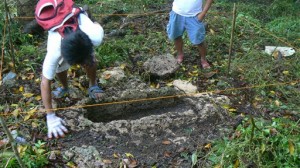
In this March 1, 2011 photo released by the Philippine National Museum, Filipino archeologist clean the area around a limestone coffin at Mount Kamhantik, near Mulanay town in Quezon province. Government archeologist have unearthed remnants of what they believe is a 1,000-year-old village on a jungle-covered mountaintop in the Philippines with limestone coffins of a type never before found in this Southeast Asian nation, officials said Thursday. AP PHOTO
LUCENA CITY, Philippines—Quezon Gov. David Suarez called on National Museum officials to continue exploring archaeological sites in Bondoc Peninsula following the discovery of a 1,000-year-old village and an ancient burial ground in the limestone Mount Kamhantik in Mulanay town.
Suarez said the exploration should be sustained as there could be more archaeological sites waiting to be discovered in other parts of Bondoc Peninsula.
Mulanay Mayor Joselito Ojeda made the same appeal to the National Museum to complete the study on the primitive village and the old grave site.
“We have plans to turn parts of the mountain into an archaeological and eco-tourism theme park with a museum that would show the rich and colorful cultural heritage of our town,” Ojeda said.
He said Domingo Garcia Foundation, which was put up by a Mulanay native, offered its full support to the theme park project.
“We have already started transforming part of the mountain as model of reforestation with our nursery of endangered tree species,” Ojeda said.
He said the forested mountain was a safe abode for several wildlife, most of them endangered like rare hornbills, wild cats and cave bats.
The Kamhantik mountain was declared a government-protected area in 1998.
Over the weekend, National Museum official Eusebio Dizon reported that archaeologists had unearthed remnants of an ancient community with rectangular limestone coffins on its burial ground atop Kamhantik.
Aside from the tombs, Dizon disclosed that archaeologists also found thousands of shards of earthen jars, metal objects and bone fragments of humans, monkeys, wild pigs and other animals in the tombs.
But Ojeda clarified that the archaeological site was not recently discovered.
He said the ancient burial ground was first discovered in 1998 during the construction of a relay station tower of a telecommunications firm atop Kamhantik.